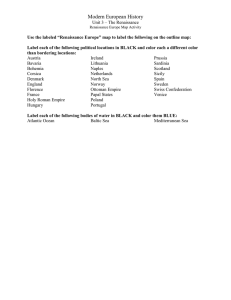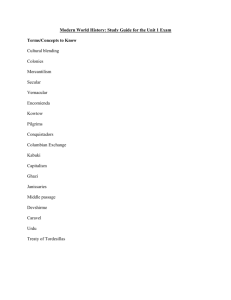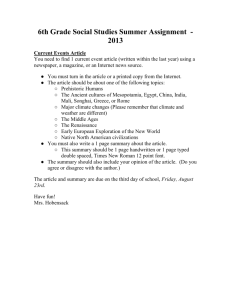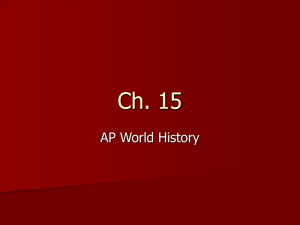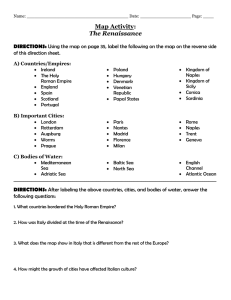AP World-Brown-Chapter 15 The West and the Changing World Balance
advertisement
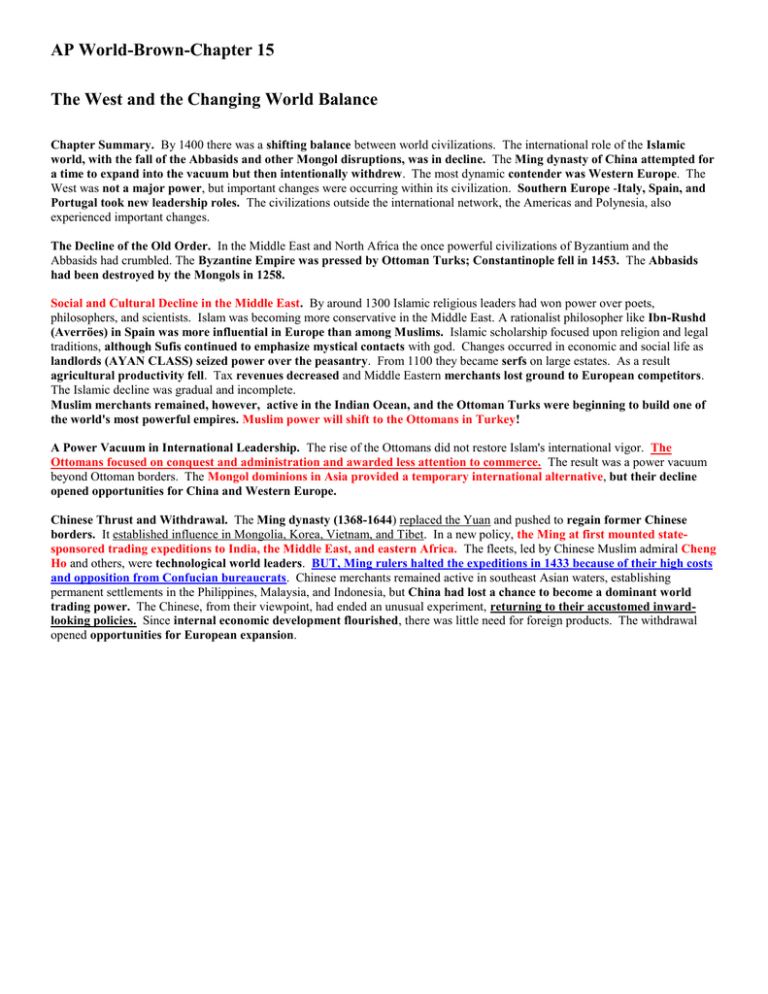
AP World-Brown-Chapter 15 The West and the Changing World Balance Chapter Summary. By 1400 there was a shifting balance between world civilizations. The international role of the Islamic world, with the fall of the Abbasids and other Mongol disruptions, was in decline. The Ming dynasty of China attempted for a time to expand into the vacuum but then intentionally withdrew. The most dynamic contender was Western Europe. The West was not a major power, but important changes were occurring within its civilization. Southern Europe -Italy, Spain, and Portugal took new leadership roles. The civilizations outside the international network, the Americas and Polynesia, also experienced important changes. The Decline of the Old Order. In the Middle East and North Africa the once powerful civilizations of Byzantium and the Abbasids had crumbled. The Byzantine Empire was pressed by Ottoman Turks; Constantinople fell in 1453. The Abbasids had been destroyed by the Mongols in 1258. Social and Cultural Decline in the Middle East. By around 1300 Islamic religious leaders had won power over poets, philosophers, and scientists. Islam was becoming more conservative in the Middle East. A rationalist philosopher like Ibn-Rushd (Averröes) in Spain was more influential in Europe than among Muslims. Islamic scholarship focused upon religion and legal traditions, although Sufis continued to emphasize mystical contacts with god. Changes occurred in economic and social life as landlords (AYAN CLASS) seized power over the peasantry. From 1100 they became serfs on large estates. As a result agricultural productivity fell. Tax revenues decreased and Middle Eastern merchants lost ground to European competitors. The Islamic decline was gradual and incomplete. Muslim merchants remained, however, active in the Indian Ocean, and the Ottoman Turks were beginning to build one of the world's most powerful empires. Muslim power will shift to the Ottomans in Turkey! A Power Vacuum in International Leadership. The rise of the Ottomans did not restore Islam's international vigor. The Ottomans focused on conquest and administration and awarded less attention to commerce. The result was a power vacuum beyond Ottoman borders. The Mongol dominions in Asia provided a temporary international alternative, but their decline opened opportunities for China and Western Europe. Chinese Thrust and Withdrawal. The Ming dynasty (1368-1644) replaced the Yuan and pushed to regain former Chinese borders. It established influence in Mongolia, Korea, Vietnam, and Tibet. In a new policy, the Ming at first mounted statesponsored trading expeditions to India, the Middle East, and eastern Africa. The fleets, led by Chinese Muslim admiral Cheng Ho and others, were technological world leaders. BUT, Ming rulers halted the expeditions in 1433 because of their high costs and opposition from Confucian bureaucrats. Chinese merchants remained active in southeast Asian waters, establishing permanent settlements in the Philippines, Malaysia, and Indonesia, but China had lost a chance to become a dominant world trading power. The Chinese, from their viewpoint, had ended an unusual experiment, returning to their accustomed inwardlooking policies. Since internal economic development flourished, there was little need for foreign products. The withdrawal opened opportunities for European expansion. The Rise of the West. The small states of the West were still a backward region during the 14th and 15th centuries. The staples of medieval culture, including the Catholic church, were under attack. Philosophy had passed its creative phase. Warrior aristocrats lost their militaristic focus and indulged in courtly rituals. The economic activities of ordinary Europeans were in disarray. Growing population outstripped food supplies, and famines were a recurrent threat after 1300. The arrival of the deadly Black Death (bubonic plague) during the 14th century cost Europe one-third of its population. Dr. Doctors with pot-puree masks Sources of Dynamism: Medieval Vitality. The West, despite the reverses, remained a dynamic society. Strengthened feudal monarchs provided effective government. The Hundred Years’ War stimulated military innovation. In Spain and Portugal regional rulers drove back Muslim occupiers. Urban economic growth continued to spur commerce, and the church accepted key capitalistic principles. Technology, especially in ironworking and timekeeping, continued to progress. Imitation and International Problems. New opportunities for imitation occurred when the rise of the large and stable Mongol empire provided access to Asian knowledge and technology. Western elites sought Asian luxury products, paying for them by exporting raw materials. The ensuing unfavorable trade balance had to be made up in gold. By 1400 gold shortage threatened the economy with collapse. The rise of the Ottoman empire and other Muslim successes further threatened Europe’s balance of trade with Asia. The reaction included the expansion in the Adriatic of the city-state of Venice and the beginning of explorations to bypass Muslim-dominated routes to Asia. Secular Directions in the Italian Renaissance. A final ingredient of the West's surge was internal change. The Renaissance, a cultural and political movement grounded in urban vitality and expanding commerce, began in Italy during the 14th century. The earlier phases involved literary and artistic themes more friendly to the secular world than the previous religiously oriented outlook. Artists and writers became more concerned with personal reputation and glory. In commerce merchants sought out new markets. City- state governments, run by the merchant class, eager for increased revenue, supported their expansion. Human Values and Renaissance Culture. The Renaissance above all was a cultural movement. It began in Florence and focused on literature and the arts. The movement stressed stylistic grace and a concern for a code of behavior for urban gentlemen. There was innovation in music and the visual arts. Painters realistically portrayed nature and individuals in religious and secular themes and introduced perspective to painting. The early Renaissance did not represent a full break from medieval tendencies. It had little impact outside of Italy, and in Italy it focused on high culture and was little concerned with science. Still, the Renaissance marked the beginning of important changes in Western development. The developing scope of Italian commerce and shipping, ambitious, revenue-seeking city-states, and seamen seeking the renaissance goal for personal glory, set the stage for future expansion. The Iberian Spirit of Religious Mission. The Iberian peninsula (Spain and Portugal) also was a key center for change. Spanish and Portuguese Christian military leaders had for centuries been pushing back the borders of Islam during the Reconquista. Castile and Aragon established regional monarchies after 1400; they united through royal marriage in 1469 (Ferdinand and Isabella).. Iberian rulers developed a religious and military agenda; they believed they had a mission to convert or expel Muslims and Jews during the SPANISH INQUISITION and to maintain doctrinal purity. Close links formed between church and state. The changes stimulated the West’s surge into wider world contacts. Western Expansion: The Experimental Phase. European efforts to explore the Atlantic began in the late 13th century. After early discoveries a rapid move was made to a colonial system. Early Explorations. The Genoan Vivaldi brothers in 1291 had vanished after passing the Straits of Gibraltar in search of a route to the "Indies." Other Genoan explorers reached the Canary Islands, the Madeiras, and perhaps the Azores during the 14th century. They never returned. Vessels from Spain sailed southward along the West African coast as far as Sierra Leone. Technological barriers hindered further exploration until 1430. Europeans solved problems through building better ships (the Caravel) and learning from the Arabs the use of the Chinese compass and astrolabe. European mapmaking also steadily improved. Colonial Patterns. The Portuguese and Spanish began to exploit the discovered island territories of the Azores, Madeiras, and Canaries. Prince Henry (the navigator) of Portugal, motivated by a combination of intellectual curiosity, religious fervor, and financial interest, reflected many of the key factors then stimulating European expansion. Land grants were given to colonists who brought along western plants, animals, and diseases. They began a laboratory for later European imperialism and the plantation system on islands off of West Africa. Large estates produced cash crops - sugar, cotton, tobacco - for Western markets. Slaves were introduced for crop cultivation. (Islands of Principe and Sao Tome) The developments were modest, but their patterns established precedents for the future. Portuguese Expansion In Depth: The Problem of Ethnocentrism. The presence of ethnocentric outlooks in most cultures creates problems of interpretation in world history. The practices of foreign peoples often are regarded as inferior. Although many civilizations looked down on others, the present power of Western standards makes ethnocentrism a real issue. It is necessary to remain openminded when thinking about other cultures, and to consider how their patterns are the result of their particular historical development. Outside the World Network. The international framework developing during the postclassical period left out many regions and peoples. The Americas and Polynesia were not part of the new international exchange. Some of their societies experienced new problems that placed them at a disadvantage when experiencing outsider intervention. Political Issues in the Americas. Both the Aztec and Inca empires experienced difficulties after 1400. Aztec exploitation of their subject peoples roused resentment and created opportunities for outside intervention. The Inca system created tensions between central and local leadership, stresses exacerbated by imperial overextension. The complications stemming from European invasion changed all of the developing dynamics of the peoples of the Americas. Expansion, Migration, and Conquest in Polynesia. Polynesian culture between the 7th century and 1400 experienced spurts of migration and conquest that spread peoples far beyond the initial base in the Society Islands. One migration channel brought Polynesians to the Hawaiian islands. After 1400 Hawaiian society was cut off from Polynesia. In Hawaii the newcomers, living from agriculture and fishing, spread widely across the islands; pigs were introduced from the Society Islands. Warlike regional kingdoms were formed. In them a complex society emerged where priests and nobles enjoyed special privileges over commoners. Rich oral traditions preserved their cultural values. Isolated Achievements by the Maoris. A second channel of migration brought settlers to New Zealand perhaps as early as the 8th century. The Polynesians adapted to the different environment, producing an expanding population and developing the most elaborate Polynesian art. Tribal military leaders and priests dominated a society that possessed many slaves gained in warfare. The Polynesians did not work metals, but they created a vigorous economy based upon agriculture and domestic animals. They produced a rich oral tradition. As in Hawaii, all the accomplishments were achieved in isolation from the rest of the world. Traditional Maori Dance Modern Maori Conclusion: Adding Up the Changes. The era around 1400 clearly was a time of transition in world history. It was the most significant alteration since the fall of the classical empires. The West was rising in significance as part of a series of complex happenings all over the world. There were shifts in international trade leadership,, in power relationships, and civilization dynamism. The changes even affected societies where existing patterns endured. Although sub-Saharan Africa continued along independent paths of evolution long after 1400, the altering world patterns were drawing Africans into a new relationship with Europe.. KEY TERMS Ottoman Empire: Turkic empire established in Asia Minor and eventually extending through the Middle East and the Balkans; conquered Constantinople in 1453 and ended Byzantine Empire. Ibn-Rushd (Averroës): Iberian Muslim philosopher; studied Greek rationalism; ignored among Muslims but influential in Europe. Ming Dynasty: replaced Mongol Yuan dynasty in China in 1368; lasted until 1644; initially mounted large trade expeditions to southern Asia and Africa; later concentrated on internal development within China. Cheng Ho: Muslim Chinese seaman; commanded expeditions throughout the India Ocean. Black Death: 14th century bubonic plague epidemic; decimated populations in Asia and Europe. Renaissance: cultural and political elite movement beginning in Italy ca. 1400; rested on urban vitality and expanding commerce; produced literature and art with distinctly more secular priorities than those of the European Middle Ages. Portugal, Castile and Aragon: regional Iberian kingdoms; participated in reconquest of peninsula from Muslims; developed a vigorous military and religious agenda. Francesco Petrarch: Italian author and humanist; a major literary figure of the Renaissance. Vivaldi brothers: Genoan explorers who attempted to find a western route to the "Indies"; precursors of European thrust into southern Atlantic. Henry the Navigator: Portuguese prince; sponsored Atlantic voyages; reflected the forces present in late postclassical Europe. ethnocentrism: judging foreigners by the standards of one’s own group; leads to problems in interpreting world history. CLASS DISCUSSION QUESTIONS 1. What were the signs of decline in the Middle East and in China? 2. What accounts for the relative rise of the West? 3. Describe the nature of the Italian Renaissance. In what way was it a strictly Italian experience? 4. What was the nature of early Western exploration and colonial patterns? 5. What accounts for the relative decline of civilizations outside the world network? 6. Summarize the transitions taking place in world history ca. 1400. LECTURE SUGGESTIONS 1. Respond to the statement that the relative rise of the West after the 14th century was not so much the result of Western innovation as the decline of civilizations in the Middle East and Asia. The statement is justified with respect to the changes occurring in the Middle East and China, but only so far as it is recognized that change rather than absolute decline took place in those regions. In the Middle East the end of the Abbasids, the rise of the Seljuk Turks, and the disruption of the Mongol empires did not cause total decline. The Ottomans began building their future major empire. The Muslim trade empire disintegrated since the Ottomans were less interested in commerce than their predecessors. This opened the door for Western trade expansion. In China there was no political disruption of traditional centralization under the Ming; there was a brief effort to expand Chinese trade throughout Asia. The Chinese withdrawal in 1433 left opportunities for the West. It can be argued that Western advances were the result of perceived weaknesses: an unfavorable balance of trade with other civilizations, a fear of Ottoman expansion led to exploration and new trade routes. 2. Discuss the differences between the world of 1500 and that of 1250. The demise of the Mongol empires led to the disruption of the links connecting the civilizations of the Eastern Hemisphere. There was relative decline in the Middle East as the great trade empire fragmented. The rise of the Ottoman Empire with its political center in Asia Minor and southeast Europe was a major political factor. In Eastern Europe Russian independence from the Mongols created a new civilization. In China under the Ming traditionalism was reasserted after the expulsion of the Mongols. In the Americas the Aztec and Inca empires were disintegrating from internal weaknesses. Polynesian groups remained culturally isolated and technologically primitive. In the West the cultural forms of the Renaissance challenged medieval culture, and Westerners were beginning exploration and attempts to gain control of worldwide trade. The steps marked the beginning of change in international leadership and dynamism. THE INSTRUCTOR'S TOOL KIT Map References Danzer, Discovering World History through Maps and Views Source Maps: S30. Reference Maps: R1-R4, R24-R25. Audio Cassettes Giovanni Boccaccio, Five Tales from the Decameron. Caedmon Documents On the Family. Leon Battista Alberti The Life of Leonardo da Vinci. Giorgio Vasari Letters. Francesco Petrarch Dialogue. Catherine of Siena From Kishlansky, op. cit. Video/Film The Life of Leonardo da Vinci. Filmic Archives Civilization: The Hero as Artist. Time-Life Films Man-The Measure of All Things. Time-Life Films Music in the Arts of the Renaissance. CC Films Epitome of the Italian Renaissance: The Gonzagas of Mantua. Films for the Humanities BN-2679 The Renaissance. Insight Media #WN41 Renaissance Art and Music. Insight Media #WN47
